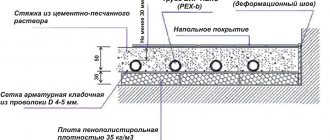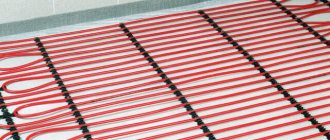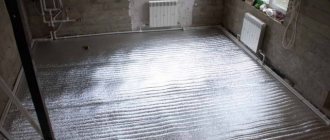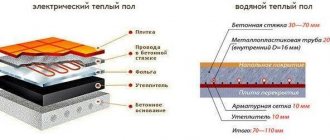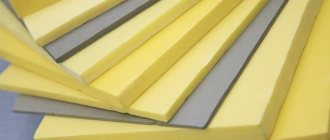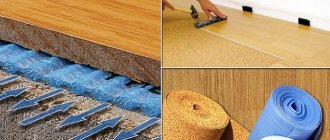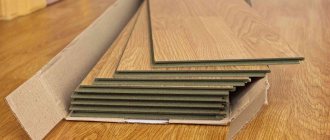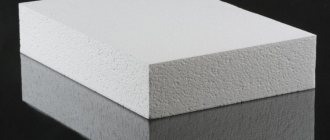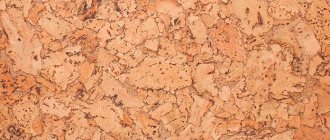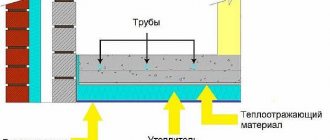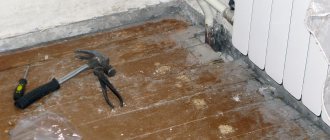Types and characteristics of polystyrene foam substrate
Polystyrene belongs to a group of synthetic polymers collectively called foam. Obtained by polymerization of styrene. The output is translucent granules, from which finished products are obtained by injection molding (pressed polystyrene) or extrusion at +190-230 degrees Celsius (expanded polystyrene).
Polystyrene granules.
The production of the substrate occurs by extruding polystyrene granules mixed with foaming reagents (volatile petroleum products and water vapor), under enormous pressure and high temperature. The result is polystyrene foam with low density (30-40 kg/m2), moisture absorption of 0.08%, thermal conductivity of 0.035 W/(MxK) and high noise absorption (up to 22 dB).
The substrate for the polystyrene foam laminate is available in the form of slabs (individual sheets or accordion) or rolls.
Sheet sizes:
- width - 50.0-60.0 cm;
- length - 100.0-120.0 cm;
- thickness - 2, 3, 5 mm.
Sheet backing made of polystyrene foam.
Sold in packs of 10 or 20 sheets. Sellers do not open the packaging, so you won’t be able to buy one or two sheets. Roll material is produced 15 m long, 110 cm wide, 2 mm thick.
The backing made of extruded polystyrene foam under the laminate can also be foil-coated, when the foam and foil are glued together. Available in sheets. Possesses:
- noise absorption - up to 23 dB;
- dynamic strength (impact) - 0.035 W/m2;
- bending strength - 0.25 MPa;
- thermal conductivity - 0.035 W/(MxK);
- compressive strength - 0.16 MPa.
The specified technical characteristics allow us to conclude that the addition of foil not only improves the basic consumer properties of a simple substrate, but also gives it a new property - the ability to waterproof.
A foil backing is used mainly under heated floors. It is laid with foil facing up, and heating elements are mounted on it, which allows heat to be reflected upward.
According to reviews on the forums, the quality is not inferior to a foil stopper, but at a significantly lower price.
Types of polystyrene substrates
The form of release can be different - slabs, sheets and rolls. The parameters of the slabs are quite impressive, their width reaches 50-60 centimeters, and their length – 100-120 centimeters. Thickness can vary from 2 to 5 millimeters.
Sheets are typically sold in packs, with an average of 10-20 sheets. This is a disadvantage, since it often leads to large material residues after repairs - the parameters are variable.
The rolled version usually has a length of up to 15 meters, a width of about 110 and a thickness of about 2 millimeters. It is worth noting in advance that if there are differences in floor height, it is recommended to use slabs, since they have a maximum thickness.
It is worth special mentioning the option of a foil backing with polystyrene foam. In this case, these characteristics are significantly improved, and in addition, it becomes possible to use a heated floor system, since the heat will be reflected upward from the material.
In addition, the foil version has a much better moisture-reflecting effect, which will not allow the substrate to accumulate water even to a small extent, which means the laminate is safer.
Advantages and disadvantages
Like any building material, the substrate for polystyrene laminate (more precisely, expanded polystyrene) has its advantages and disadvantages in comparison with similar materials. The advantages include:
- the ability to maintain elasticity due to the high strength of the molecular bonds of the material during compression, as a result of which the floor covering retains its integrity and beauty for a long time;
- long service life, coinciding with the service life of the laminate;
- absence of deformation during prolonged exposure to heavy objects (under the legs of furniture, the polystyrene backing is able to restore its dimensions over a long period of time);
- high thermal insulation properties - the porous structure conducts heat poorly;
- good level of noise absorption - up to 70% or 22 dB;
- retains its properties in a wide temperature range - from -50 to +75 degrees Celsius, which allows polystyrene material to be laid under laminate or linoleum in unheated rooms (dachas);
- the ability to ensure air circulation on the concrete surface of the screed or waterproofing material (ribbed underside), as a result of which condensation does not form under the laminate;
- environmentally friendly - safe for the environment (does not rot);
- quality corresponds to price;
- the ability of the cellular structure to prevent the formation of condensation, and when it occurs, to absorb moisture, which makes it possible not to waterproof the floor screed;
- accuracy of sheet dimensions in length and width, which simplifies the installation process;
- light weight and compact packaging, allowing the polystyrene foam pad to be transported in passenger cars.
There are also disadvantages, but very few:
- low leveling ability - with a thickness of 3 mm, it is not able to eliminate the impact of irregularities of more than 1 mm on the flooring, as a result of which creaking quickly appears;
- has a temporary drawdown that will go away in 4-5 weeks;
- not sold in sheets, but only in packages, as a result of which quite often a large balance arises - a loss of the family budget;
- low resistance to aggressive environments (easily dissolves in gasoline, acetone, chloroform, etc.), with the exception of ammonia, alkalis, alcohol, propane;
- highly flammable due to the high content of carbon (92%) and hydrogen (8%) in the composition;
- in packages, sheet material is constantly curved;
- fragility of the substrate under strong bending.
Testing polystyrene foam for flammability.
Types of insulation and their characteristics
For thermal insulation of wooden and concrete bases, various categories of insulation from natural materials, mineral insulators and polymer solutions are used.
Coniferous slabs
The basis of this insulation is crushed coniferous wood and pressed pine needles. The porous structure of the substrate with an environmental composition provides excellent heat and sound insulation properties. Coniferous boards are characterized by wear resistance and have good leveling abilities. When installing a floor, an insulating substrate with a porous structure is used together with a high-quality steam-hydrobarrier.
Cork substrates
The material is distinguished by its impeccable heat and sound insulation characteristics and wear resistance. The only disadvantage of cork backing is its high cost, but the impressive performance potential of the product easily offsets the costs. The product is made from the bark of the cork tree. No artificial adhesives are used in the production of the material; the composition of cork insulation is extremely environmentally friendly.
Mineral wool
For internal thermal insulation, the basalt variety of mineral wool is mainly used. The material has high functional qualities, but when exposed to moisture, it loses its ability to insulate due to shrinkage. It is effective to use a mineral insulator in combination with a reliable hydro-vapor barrier. When deciding which insulation is best for laminate flooring for thermal insulation of a wooden floor, most often they choose basalt wool mats and slabs.
Mineral wool is a possible insulation material for laminate flooring
Foil insulation
Reflective material is in demand due to its high resistance to external loads and durability. When thinking about whether it is possible to put foil insulation under the laminate, you should choose products depending on the material of the structure being installed:
- for wooden bases, priority is given to self-adhesive insulator with a reflective effect;
- To insulate a concrete floor under a laminate, it is recommended to choose insulation with a metallized coating, since aluminum foil is destroyed by alkalis in the cement solution.
Types of foil insulation for laminated flooring:
- insulation on foamed polyethylene. The product is produced in rolls with a thickness ranging from 2-10 mm. The foil product is in demand in the installation of underfloor heating systems, and is also relevant as an insulating substrate for floor coverings;
- heat insulator based on varieties of mineral wool. Fiber products with foil coating are presented in rolls and mats with thickness parameters in the range of 50-100 mm;
- foil insulation based on foamed polystyrene. The material is produced in the form of hard mats, suitable for laying warm water floors.
The products are also in demand for thermal insulation of surfaces subject to dampness and intense loads.
Extruded polystyrene foam
An improved type of polystyrene foam - EPS - has many advantages, including:
- low thermal conductivity coefficient;
- excellent sound absorption properties;
- moisture resistance;
- inertness to bioagents and pathogenic microflora;
- resistance to temperature changes;
- ease and convenience of installation.
Extruded polystyrene foam - a possible insulation under laminate
They produce modifications of extruded polystyrene foam of different thicknesses with flat edges and milled grooves.
Polyethylene or polystyrene?
There is an interesting confusion in life: due to the fact that foamed polystyrene and polyethylene are classified as foam plastic, professional builders often confuse them. However, these are completely different materials, with different characteristics and, naturally, prices.
Foamed polyethylene can be cross-linked (abbreviated PPE) and non-cross-linked (NPE). Both types of material (Izolon, Stenofon, Porilex) have the lowest price among substrates (15-28 rubles/m2). But this does not mean that they are of equally low quality.
Non-crosslinked polyethylene foam (NPE) does not have a cross-linking network at the molecular level, which leads to rupture of the material under significant loads. In cross-linked polyethylene (XPE), the hydrogen atom is replaced by a carbon atom during the manufacturing process, resulting in the formation of molecular bonds in all directions (hence cross-linked). This polyethylene significantly exceeds NPE in all indicators:
- density - 30% higher;
- strength - 40-50% higher;
- long service life - almost 2 times longer;
- high level of sound insulation (NPE has practically none);
- thermal conductivity - 20% lower.
However, cross-linked polyethylene foam is still slightly inferior in quality to the polystyrene substrate, which is reflected in the price. For expanded polystyrene it is in the range of 35-50 rubles/m2.
Conclusion: based on prices and quality characteristics, PPE is the best foam backing for linoleum. For budget renovations, it is better to lay expanded polystyrene under laminate or parquet.
The best insulation for wooden floors
Insulation of wooden floors is carried out from below, under the main boards, which are subsequently finished with the main coating. This reduces the risk of swelling of the top layer. For such surfaces, penoplex, stone wool, etc. are used. Before understanding which insulation is best for the floor of a wooden house, 10 nominees were analyzed taking into account their safety, ease of installation and durability.
Penoplex Comfort 118.5 x 58.5 cm 50 mm
A new generation of heat-insulating material used for finishing not only floors, but also walls, roofs, and foundations. Extruded polystyrene foam is suitable for both external and internal work. It comes in the form of slabs measuring 118.5 x 58.5 cm, which makes the installation process convenient and quick. The model can be used without consequences in a wide temperature range – from -50 to +75°C.
Penoplex has a good density - 25 kg/m³, so it reliably retains heat and at the same time has some soundproofing properties. In this regard, it is also relevant for finishing interfloor ceilings in a house. Due to water absorption at the level of 0.4%, the accumulation of liquid inside and the appearance of unpleasant odors is eliminated, but the vapor barrier should not be completely ignored. The insulation is durable in compression and can withstand high mechanical loads.
Advantages:
- The area covered by one sheet is 0.7 m²;
- Good waterproofing;
- Ease of installation;
- Long service life (up to 40 years);
- Low thermal conductivity – 0.033 W/(m⋅K).
Flaws:
Sometimes attacked by rodents.
Sheets are produced with a thickness of 5 cm and a density of 25 kg/m³, which is sufficient for a wooden (frame or log) house, including an attic. At the same time, they do not take up space and are relevant for low ceiling heights.
TechnoNIKOL Rocklight 1200 x 600 x 50 mm
When trying to decide what kind of insulation to put on the floor, it should be noted that stone wool is supplied in slabs, which makes it easier to install. This material does not burn and can withstand temperatures up to 870ºC. It has, along with heat-insulating, sound-absorbing properties due to its dense structure - 35 kg/m³. This option is suitable for installation between joists under laminate, parquet, linoleum, and solid boards.
TechnoNIKOL Rocklight has low heat losses - 0.041 W/(m⋅K), which reduces home heating costs. The insulation is resistant to compression, allowing it to be used in areas with high traffic. It practically does not absorb moisture - its absorption coefficient does not exceed 2%. Thanks to this, the material can be used when arranging floors on lower floors, including above the basement.
Advantages:
- Resistance to rotting;
- Not affected by mold;
- The optimal sheet area is 0.72 m²;
- 8 sheets per pack.
Flaws:
Weighs 10.28 kg.
Stone wool does not lose its performance characteristics over a wide temperature range: from -180 to +700 degrees. Due to this, it can be used for thermal insulation in rooms with high fire safety requirements.
Isolon 500 3020 AV/AH 1m 20 mm
A universal material used in construction for steam, sound and heat insulation. The insulation is produced in the form of a slab 1 m wide. It covers an area of 2 square meters. m, which allows for quick installation. Its density of 33 kg/m³ makes it possible to thermally insulate a room with a concrete floor, including under a screed. Izolon is also relevant for finishing above the basement.
Isolon 500 3020 AV/AH has a low thermal conductivity coefficient of 0.036 W/(m⋅K), which reduces the need for additional heating. The use of a slab significantly reduces the thickness of the interfloor “pie” and eliminates excessive pressure on the load-bearing parts of the building. This is a fireproof material that does not support combustion. Good steam and moisture protection make it possible to install the material in Finnish saunas, rooms with a swimming pool, and baths.
Advantages:
- Eliminates leakage through the floor;
- Reflects heat;
- Protected from UV rays;
- 15 sheets per pack;
- Suitable for outdoor use.
Flaws:
Not detected.
Popular manufacturers and prices
When planning to buy foam polystyrene for the substrate, you should keep in mind a few points:
- no laminate or parquet manufacturer recommends polystyrene foam underlay for their products and, therefore, does not provide a guarantee for the floor covering;
- the foamed polystyrene substrate successfully performs all the functions of the damper layer;
- For many buyers, a low price is a priority over a warranty on flooring.
Production of polystyrene foam substrate.
Linings for extruded polystyrene laminate are produced in Russia, Poland and China (such products are not sold in other countries of Europe and America - natural materials are a priority there) for the population of the countries of the former Soviet Union.
The most popular brands are:
- The company VTM IsoPolin (Isopolin) (Poland) produces products in the form of rolls and sheets with a thickness of 2, 3 and 5 mm. Roll dimensions 20 m x 1.1 m x 2 mm, slab dimensions - 100 cm x 50 cm. Thickness may vary. It fits not only under laminate, but also under wooden floors. In terms of its technical characteristics, the XPS substrate occupies a middle position between cork and NPE. High quality is accompanied by an appropriate price - from 55 rubles/m2;
- “Izoshum” (Russia and the Republic of Belarus) is considered the best in terms of price and quality ratio. Available in a thickness of 3 mm and an area of 0.5 m2. Pack contains 20 sheets. The price starts from 25 rubles/m2;
- “Solid” (Russia, Aramil, Sverdlovsk region) - produced in the form of single sheets and accordions with a thickness of 2 to 5 mm. The package contains 5.25 m2 of simple substrate and 52.5 m2 of accordion. Prices start from 55 rubles/m2;
- Aberhof - a German company produces a 5 mm thick underlay for floor screed with a height error of up to 3.5 mm. The package contains 5.25 m2 (10 sheets). For 1 m2 you will have to pay, oddly enough, only 25-30 rubles. The disadvantages include rapid shrinkage. However, among this type of substrate, with high leveling ability (3.5 mm), it is the undisputed leader.
Insulation for concrete floors
Thermal insulators are used for laying both under screed and on top of concrete. Slab and roll mineral and ecowool, polystyrene foam and penoplex, polyurethane foam are suitable for these purposes. Having considered 10 options, VyborExpert specialists selected 3 floor insulation materials for concrete, eliminating the least safe, easy to install and affordable ones.
Foam plastic PSB S-15 1000 x 2000 x 100 mm
Polystyrene foam PSB S-15 is widely used in insulation of residential premises. It consists of 98% air and 2% foam. Thanks to this distribution of components, it is also characterized by good sound insulation properties. The dimensions of the sheets are considerable - 1 x 2 m, but if necessary, the insulation is cut easily and with virtually no waste.
This material is not subject to deformation due to its compressive strength of 0.04 MPa. Due to its resistance to water, which absorbs no more than 4% per day, it can be used in any zone: dry, normal, wet. The insulation does not lose its characteristics at temperatures from -60 to +80℃. A sheet thickness of 10 cm is irrelevant except for rooms with low ceilings.
Advantages:
- Vapor permeability – 0.05 mg/(m.h.Pa);
- Density – 8 kg/cub.m;
- Non-porous structure;
- Can be used in different climatic regions;
- Fire safety.
Flaws:
Due to their large size, the sheets often have to be cut.
Chipboard QuickDeck tongue and groove moisture resistant Plus 1200 x 900 x 16 mm
The material is included in the rating due to its availability and ease of installation due to the presence of grooves on both sides. It is resistant to moisture, so it is used for floor insulation in bathrooms and bathhouses. Its main advantage over alternative options is environmental friendliness, because deciduous and coniferous species are used for the production of sheets.
This floor insulation is characterized by better sound insulation and has low thermal conductivity, maintaining a comfortable room temperature, despite its small thickness (1.6 cm). This can be explained by the high density of the sheets - 550-820 kg/m3. It is completely safe for humans, since it burns weakly and emits no more than 10 mg of formaldehyde per 100 g.
Advantages:
- Convenient dimensions – 1200 x 900 cm;
- No unpleasant odor;
- Suitable for arranging walls and ceilings;
- Relevant for outdoor work;
- When cutting, there is a minimum of waste.
Flaws:
Not suitable for laying under screed.
Reviews note that when laying chipboard under a finished floor covering on joists, the distance between them should be no more than 30-40 cm.
Black cork agglomerate 50 mm Amorim
The material is used for heat and sound insulation of residential and non-residential premises. It is made by pressing small particles of wood, which are glued together under the influence of natural resins. Cork agglomerate does not contain synthetic additives, thereby eliminating the risk of releasing harmful substances. It is distinguished by its hypoallergenicity and resistance to attacks by rodents and insects.
Technical agglomerate made from cork is sold in sheets 5 cm thick, due to which it practically does not take up space. One package sells 6 pieces. the total weight is 17.2 kg, so it is convenient to lay the material. It is actively used as a heat and sound insulator when installing “warm floors”.
Advantages:
- Does not contribute to the spread of fire;
- Compressive strength;
- Low thermal conductivity;
- After swelling, it dries and does not lose its shape.
Flaws:
- Passes vibration waves;
- High price.
Laying nuances
In principle, there are no significant differences in laying polystyrene foam underlays compared to other types of underlays for laminate flooring. An exception is the location of the polystyrene foam material in relation to the laminate:
- the rolled underlay is positioned perpendicular to the floor covering;
- The slabs are laid at an angle of 45 degrees relative to the parquet or laminate.
Laying the substrate.
The rest is the same procedure:
- Before work begins, the substrate is brought into the room and unpacked so that the material takes on geometric dimensions suitable for the temperature and humidity of the room where it will be installed;
- Some of the slabs are cut diagonally from one corner to the other and laid near the walls;
- A strip is laid out lengthwise for the installation of several strips of laminate. It's better to play it safe here - this is one of the few types of substrate on which you can walk. But it’s better not to take risks, especially since there are no problems with this scheme of work;
- The joints are glued together with masking tape or construction tape;
- Laminate is installed;
- The next strip of substrate is laid out, etc.
There are some nuances when laying rolled material. The problem here is the constant curling of the cut backing sheet. Attempts to straighten it often lead to it crumbling and then breaking. The solution to the difficulties that arise is simple - cut the sheets to size, unfold, put something heavy on the ends and leave for a couple of days. During this time, internal tension will weaken and the problem will disappear.
What types of polymer are there?
The insulation under the laminate must be selected based on thickness.
On an industrial scale, three main technologies for manufacturing foam sheets are known to produce products with different performance qualities:
- method of non-press forming;
- use of special pressing equipment;
- obtaining material in the extruder installation.
Any of the methods allows you to obtain a high-quality product designed to perform certain thermal insulation tasks.
Pressless polymer product
By pressless we mean expanded polystyrene, consisting of granules of the same diameter, tightly connected to each other under the influence of a thermal process. The density of the structure determines the strength of the product and ranges from 50 to 15 kg per cubic meter. The product is marked with the abbreviation PSB with numbers at the end indicating hardness. The product can be used as insulation for walls and roofs of buildings, various metal containers and as polystyrene foam under laminated floors.
High-quality plastic can be easily distinguished from low-quality plastic by breaking the sheet and checking the diameter of the grains - grains of different sizes indicate a fake.
Pressed polystyrene foam
Both types of expanded polystyrene are suitable for coating - pressed and non-pressed
PS - this is a product that is produced on pressing equipment by compacting latex grades of raw materials using gasifiers. The structure of such plastic consists of closed cells. Main characteristics of the polymer structure:
- lack of electrical conductivity;
- low water absorption;
- heat retention;
- blocking the passage of sound waves;
- unsuitability for the development of pathogenic flora.
The pressed polymer structure can be used in radio engineering, since it is transparent to the passage of radio waves.
Extruded material
Extruded polystyrene foam is completely impermeable to water.
When making extruded polystyrene foam (EPS), the raw materials are melted in an extruder and then filled into a mold. The hardened mass has uniform cells and is almost completely waterproof. In addition, performance indicators with regard to mechanical loads are much higher than those of any other similar polymers. The product can be used for any insulation purposes, including as a substrate under a polystyrene foam laminate.
There are fire-resistant EPS brands made with the addition of fire retardants to the structure.
Laying technology
Thick slabs are laid in a checkerboard pattern, rolled material is laid with an overlap
. The main condition when organizing the substrate is that the joint between sheets or rolls of polymer does not coincide with the joint of laminate or parquet boards. This is achieved by laying the insulation at an angle to the finishing coating of approximately 45 degrees. The rest of the technology comes down to the following steps:
- Dirt and fine debris are removed from the concrete surface.
- The screed is covered with a layer of vapor barrier.
- The polymer structure is laid in a checkerboard pattern.
In order not to trample the surface, you can lay the insulation in parts the width of two strips of board.
Technical cork (cork backing for laminate)
The popularity of cork in the wake of the passion for natural materials is understandable. But is cork underlay for laminate flooring really that good, the price of which is higher than for other products of similar purpose?
Technical cork in rolls is made from cork oak chips. The advantages of a substrate made from natural raw materials include the following properties:
- environmentally friendly and hypoallergenic;
- low thermal conductivity;
- high sound absorption;
- ability to mitigate vibration and shock;
- antiseptic properties (prevents the appearance of mold and rot);
- wear resistance;
- durability.
The cork backing (lining) under the laminate does not react with components of household chemicals.
The material is practically not pressed under load and hides the unevenness of the base well. It is also resistant to fire and, when exposed to fire, smolders slowly, preventing the spread of fire.
As can be seen from the above, cork (underlay) is an excellent choice for arranging floors, but it is not advisable to use it for laying cheap laminate flooring.
The economic aspect plays an important role in the choice of building materials. But savings can be viewed in different ways. For some, a low price is preferable, while others focus on reliability and long service life. Cork underlay for laminate (technical cork), which can be purchased in Moscow in the Dominar online store, is suitable for those who place emphasis on naturalness and quality.
Rolled backing for laminate (polyethylene) Egen
If price is critical when purchasing a laminate underlay, then it is recommended to pay attention to polyethylene foam material. At a low cost, it has such advantages as:
- resistance to alkalis and acids;
- absence of rotting even in conditions of high humidity;
- high thermal insulation coefficient;
- shock absorption and compression;
- noise-insulating properties;
- long service life.
The rolled backing under the laminate (polyethylene foam), even with a small thickness, does not allow water vapor to pass through, which has a destructive effect on many types of floor coverings.
The canvas provides reliable protection against condensation, which often forms on the cold floor of the first floors.
Foamed polyethylene (backing for laminate) 2 mm and 3 mm Egen brand can be purchased on our website. The price will not be prohibitive even for the most modest budget.
The material has good ductility and is able to hide unevenness of the subfloor. The dies mounted on a laminate backing do not bend or creak when walked.
The Egen backing (polyethylene foam) is easy to use. Do you just need to properly prepare the base? level thoroughly and dry. If a cement-concrete screed was used, you should first check the percentage of surface moisture. This is done using a piece of polyethylene, which is attached to the floor overnight. The absence of condensation indicates that the floors are ready for further finishing.
To ensure better waterproofing and prevent movement of the sheets, the rolled backing under the laminate is laid end-to-end, and the seams are taped.
Extruded polystyrene
Produced by extrusion, which produces a harder and denser material. The manufacturing process involves mixing polystyrene granules with a blowing agent in a special machine called an extruder.
The entire production technology is carried out at high temperatures and under high pressure. Today on the market you can find rolled and tile backing options. Such polystyrene externally resembles foam plastic, but internally polystyrene is more durable and has a lower degree of water absorption.
